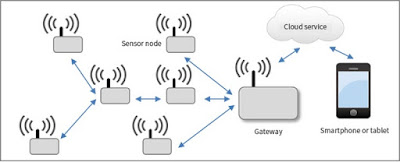Wireless Sensor Networks
A wireless sensor network (WSN) is a group of specialized transducers which use placed in diverse locations to monitor physical conditions. A WSN system is composed of multiple sensor nodes that are small and light hence portable. Each system is a has a gateway that provides wireless connectivity back to the wired world and amongst the nodes. There are numerous wireless protocols that can be used with WSN, the protocol is picked based on application requirements.
Components of a sensor node
Every sensor node is made up of the following
- Transducer
- Transceiver
- Power source
Transducers
Commonly monitored parameters include pressure, humidity, temperature, chemical concentrations, wind speed and direction, sound intensity, pollutant levels, power-line voltage, illumination intensity and some body functions. Transducers that can convert energy from one form to another are required to sense these parameters and convert them to another form of energy that can be measured and translated. Sensors are the best transducers for such tasks. It is for this reason that sensors form a better part of the nodes. Commonly used sensors include;
- Pressure sensor
- Motion sensors
- Hall sensors
- Temperature sensors
- Humidity
- Infrared sensors
There are many other sensors that are used by the nodes. The choice of sensors is entirely based on the application of the WSN.
Microcomputer
The role of the microcomputer is to process and store sensor output. Most microcomputers are surface embedded chips. One such microprocessor is the Xeon D-2100. Power consumption plays a key role when picking a microprocessor. Low consumption is often traded-off with processing speed hence the x86 architecture is rarely used for battery powered devices.
You May Also Like This:”
Transceiver
A transceiver is made up of both a transmitter and a receiver. The transceiver is responsible for the communication of the wireless sensor node with other nodes and with the base station. It is made up of the front end, back end and assisting components, for instance, DACs, ADCs, mixers, voltage oscillators, amplifiers, frequency synthesizers and phase locked loop. All these components require a lot of power to run hence why the transceiver is the biggest power consumer in a node. Based on their mode of operation, a transceiver can either be half or full duplex. A transceiver that cannot transmit and receive at the same time is called a half-duplex transceiver while that which can do both at the same time is referred to as a full-duplex transceiver.
Power source
The most prevalent power source in WSN nodes is batteries. Besides the demand for longer lasting batteries, the size and weight of batteries come into play when considering one for use with WSN nodes. Owing to their ease of availability, carbon-zinc and alkaline batteries are commonly used. In order to extend battery life, ZigBee is often used in many WSN systems since it consumes low-power. To further tame power consumption, WSN nodes periodically wakes and transmits data and then slides back to the standby mode so as to conserve energy.
There are many types of transceivers, transducer, microcomputers available in the market. There are also very many manufacturers of the same. As a WSN designer, you might have to pick them out keenly so as to ensure that whatever components you pick suits well with your application.
Source: https://blog.enrgtech.co.uk/wireless-sensor-networking-products/






0 Comments